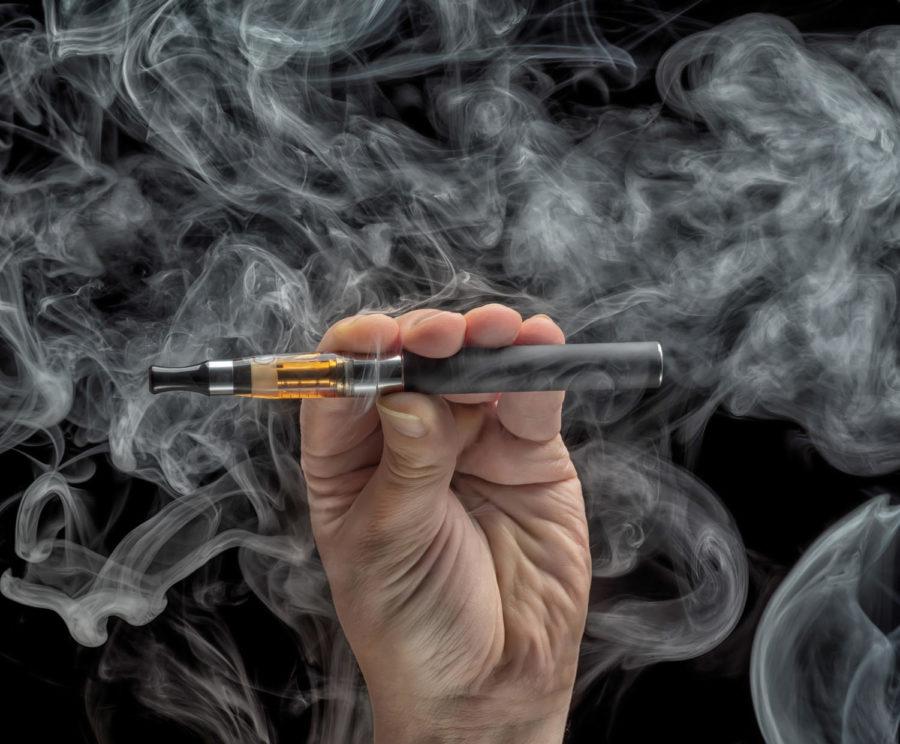Sinclair: E-cigarettes pose a hidden danger
e cigs
January 19, 2017
By this point in time, everyone has heard of or knows someone who smokes e-cigarettes, or “vapes.” This may seem like a healthy alternative to cigarettes, and it sure is advertised as just that.
Despite what it may seem like, it is far from the truth. E-cigarettes and vaping have similar dangers to cigarettes, are falsely advertised as beneficial products and should have more regulations put upon them.
E-cigarettes, according to the FDA, “are devices that allow users to inhale an aerosol containing nicotine or other substances.” They are powered by batteries and have refillable tanks.
The tank is filled with a liquid that provides the flavoring and nicotine found in e-cigarettes. This liquid is heated and turns into the vapor that you inhale when you smoke an e-cigarette.
When e-cigarettes first came out on the market, they were advertised as a healthy alternative to cigarettes. They were presented as a tool to help people quit smoking cigarettes by providing a healthy substitute that would slowly wean people off cigarettes.
The problem with these claims is that e-cigarettes are still addictive and dangerous in hauntingly similar ways to cigarettes. One risk of e-cigarettes is that in the flavoring, there are many toxins and chemicals that are safe to ingest, but not to inhale. There is very little regulation on the FDA’s part in this area, leaving the safety of these flavoring liquids as a large unknown. There needs to be stronger regulations on the flavoring liquids and more research needs to be put into the effects of inhaling these chemicals.
The largest and most dangerous risk of e-cigarettes is that they contain nicotine, which is one of the primary ingredients found in cigarettes. Nicotine is an addictive substance that is an easy addiction to pick up, but almost impossible to break. Nicotine is especially dangerous to teens and young adults.
If adolescents inhale nicotine, it can cause behavioral and cognitive problems. Adolescent brains are not fully developed, and the nicotine can disturb its development, especially in the areas that affect attention and memory.
Considering how addictive and dangerous nicotine is to young adults, it is especially concerning to learn that “more than 18 million U.S. middle and high school youth were exposed to e-cigarette ads in 2014.” These advertisements are aimed directly at young adults. They frame e-cigarettes in a manner that makes them seem like a cool, hip activity that all teenagers are currently a part of.
Advertisements also hit home the flavoring of e-cigarettes, one of the biggest selling points for teens. What is even more ridiculous is that spending on e-cigarette advertisements has increased from $6.4 million in 2011 to $115 million in 2014. Not only is the most vulnerable group being aggressively targeted, but more money than ever is being funneled into this effort.
And it’s working. The surgeon general found that between 2011 and 2015, “e-cigarette use among high school students increased by 900 percent.” That is an incredible increase of usage in such a short span of time.
Now, even with all this clear evidence of e-cigarette risks, I must admit that e-cigarettes are slightly better than smoking cigarettes. But this does not mean e-cigarettes are the way to go.
In 2016, a study found that teens “that never smoked but used e-cigs were six times more likely to try cigarettes compared to kids who don’t vape.” Even if e-cigarettes are barely better than cigarettes, they can have almost the opposite effect than intended or advertised.
Teens who smoke e-cigarettes will seek a bigger dose of nicotine after a certain point, and cigarettes provide that bigger dose that they are looking for. E-cigarettes don’t slowly wean people off cigarettes; they actually slowly lead them to cigarettes.
The change that needs to happen is in how these products are presented and regulated. I believe there needs to be more honest advertising about these products. Companies shouldn’t be able to convince young adults to smoke their life away because e-cigarettes are cherry flavored.
And, yes, you can say smoking is a choice, but corporations must be held accountable for what they say about their products and make sure their messages are presented in an honest way. In terms of regulation, the FDA needs to have stricter regulations on e-cigarettes. More oversight will lead to more research and information on the safety of these products — something consumers should have available to them.
E-cigarettes being regulated by the FDA as a tobacco product is a great start, but there is much more that can be done. There needs to be more responsibility taken by the FDA and corporations that produce e-cigarettes in order to protect the health of Americans.







